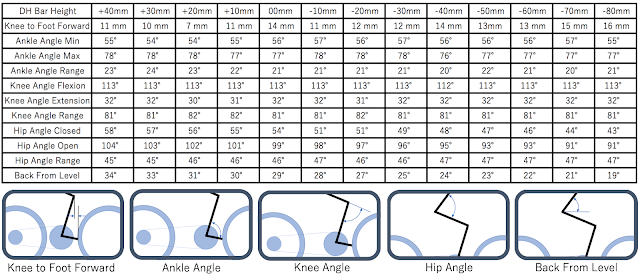Hypothesis
- The angle of the pelvis on top of the bike directly affects how you move your thighs while pedaling. As such, the pelvic range for a given rider will be associate with a similar leg articulation range. The optimal angle of the pelvis is to some extent determined.
- Up to a certain point, lowering the handlebars will cause your chest to lower, resulting in a decrease in Torso Angle. We’re interested in seeing if Pelvic Angle changes as Torso Angle lowers, and how this may impact pedaling.
Test
For this test, we used a RETÜL fitting bike.
We
took the handlebar height of a normally set-up road bike fitted with DH
bars set with 0mm rise/drop. Based on that reference point, we measured
from +40 mm > -80 mm. Keeping at 80% FTP and 90 rpm, we started at
+40 mm and then lowered the handlebars in 10 mm intervals every minute.
No large changes were seen in Foot AR Q1 or Foot AR, and while there was a small decrease in Leg AR, no significant change occurred (Table 1).
Looking
at the changes in Pelvic Angle and Torso Angle, Pelvic Angle starts
decreasing drastically when the DH bars are lowered beyond -20 mm.
Compared to Pelvic Angle, Torso Angle decreases proportionally with the
reduction in height of the DH bars (Figure 1).
If
we look at the difference between Pelvic Angle and Torso Angle, up to
-30 mm it shows a steady increase, then shows little change, and finally
decreases at -80mm.
Additionally,
from the RETÜL measurements we can see changes in Hip Angle Closed and
Hip Angle Open, which are affected by the angle of the pelvis and chest.
In contrast, for values such as Knee to Foot Forward, which may change
depending on where the rider sits in the saddle, we can say that any
changes are within the margin of error.
In
this test, we can probably say that changes in handlebar height are
dealt with by changing the angles of pelvis and torso, without changing
sitting position.
Summary
- Up to -10 mm, Pelvic Angle is stable at 54.5° to 55.5°, so it appears that this is the optimal pelvic angle for this rider.
- From around -30 mm, in conjunction with the decrease in Torso Angle, Pelvic Angle also begins to decrease, so there is a possibility that the rider is sacrificing comfort here. Even at -20 mm, Pelvic Angle is starting to decrease, but we can say that this is a transitional period in which the reduction in Torso Angle is making up the difference.













